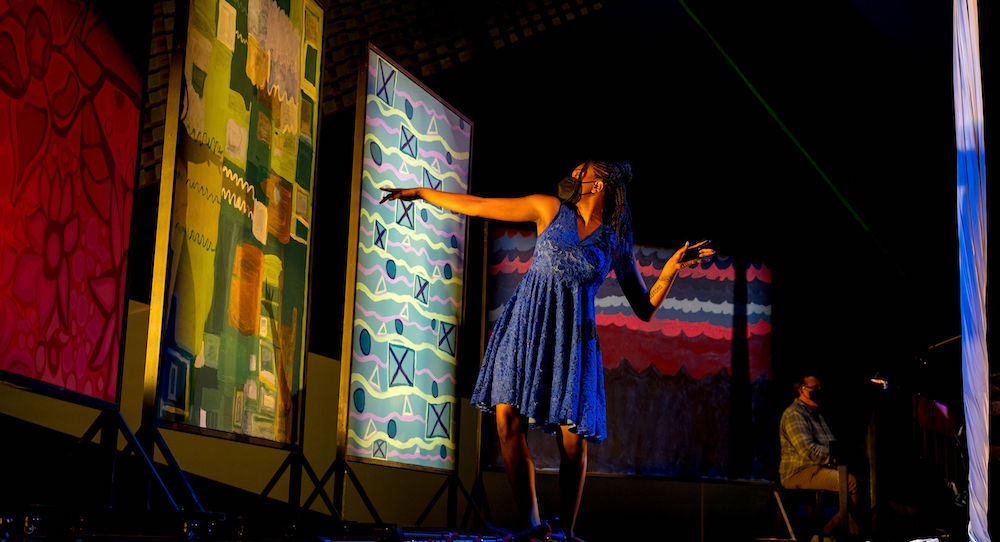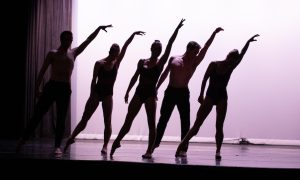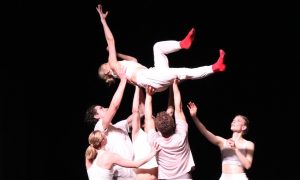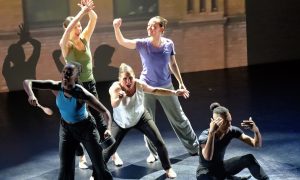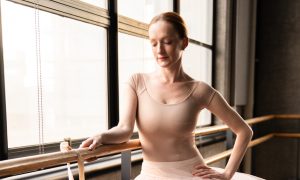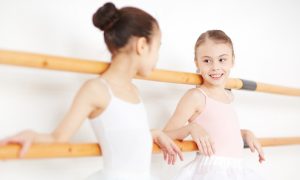The Calderwood Pavilion, Boston, MA.
November 4, 2022
Creating a whole new world, of shifted values and disrupted systems and structures: it can seem impossible. Yet, what if it weren’t? One thing is for sure: we need to envision that world before we can build it. Abilities Dance Boston (ADB) did just that with Inversion. Through thoughtful choreography, invested performances and bold design, the program demonstrated the power of art – and the deeply visceral art form of dance in particular – to make tangible an idea of something different, something better.
Before a step was danced, Executive and Artistic Director Ellice Patterson explained the access points of an ASL interpreter and audio descriptions (edited by Amber Pearcy) – and how these offerings fit into the company’s mission of art offered in universal design – which all audience members can access, no matter their disability status. Underscoring ADB’s community-centered ethos, she also acknowledged sponsors, collaborators, community partners – it’s the “village” that this artmaking has taken.
Those partners included Gateway Arts, an organization working with disabled individuals to create visual art. Patterson noted how those artists created their works while listening to ADB Director of Music Andrew Choe’s score for a seven-piece orchestra, for Inversion. Patterson also thanked Common Circus for their adaptive aerial assistance. It all seemed incredibly layered and rich – and I was quite excited for the show to get going, to experience it all.
As voiceover, Patterson asked, “What if we recreated the story and put ourselves in the middle?” “Ourselves” there was the marginalized: those pushed outside of the spheres of power, access and opportunity. This seemed to be a central question guiding the program: “inversion” of the widespread norm and narrative. “You are now arriving in Boston…” Patterson said as the curtain rose on an ensemble of dancers. This Boston has been inverted, continued Patterson, where issues once seen as too “unseemly” could now be talked about.
Infusing an intriguing play with the larger concept of time, Patterson’s audio description also described a timelessness of this Boston: not attached to past, present, or future. The fresh design – full of various colors and patterns, and linear shapes angled in unexpected ways (stage design by Janie Howland) – further pulled me right in. Paintings from the artists of Gateway Arts were pleasing punctuations within this design, compelling through abstraction yet accessible through understatement.
The ensemble began moving through balletic movement, with the graceful lilt of waltz but also clear modern dance elements: Graham-like spinal contractions, wide stances, parallel attitudes. Perhaps part of this new future is openness to all creative possibilities, I thought. In whatever codified movement system, the movement took time for full breath. It unapologetically took up space for expanding wide across the stage.
There was a narrative underlying this movement, as well. A soloist offset a trio of “gal pals,” women whose feminism was short of intersectional. The division between dancer and dancers was clear in the space, remaining physically disconnected. Toward the end, however, they got closer in space and even found physical contact at points. More harmony arose in the movement (in both vocabulary and quality) as the “gal pals” learned to question and leave behind unconscious narratives and biases.
The audio description, continuing throughout the work, evidently enough expanded accessibility. Yet, it also clarified parts of this narrative, these women learning about what they still needed to learn. It was a lot for words alone to handle, and the writing accomplished that well. At times, it felt like Patterson had to speak a bit fast to fit it all in. It was a very tough balance to hit, and ADB is the only company I know of to even attempt it – and that I very much commend.
A lovely unison section toward the end of this section led into a memorable moment: all four in the ensemble, facing inward, raised a knee and connected their feet in a circle – the feet that carried them through that work of learning, unleaning, and working towards equity. “And it’s just the beginning,” affirmed Patterson in the audio description.
The next section, “Racial Equity Ableism,” offered more notably resonant movement. A gesture of wrists rolling around one another illustrated the confinement in learning and personal growth; it can certainly be uncomfortable. Offering a contrasting malleability and free range of motion, dancers rippled their arms like seaweed. Various levels and shapes provided even more to take in and enjoy – but not too much as to be overwhelmed or numbed to dynamism.
Another quality that caught my eye was slower speed in movement, further underscoring how change can be slow and uncomfortable. A slower speed, short of the panicked urgency of the modern world, is necessary for moving forward; it takes time to pause, listen and question, as the audio description affirmed.
The lights came down and back up again on the next section, the duet “Neurodivergence Abstraction” (danced by Jamie Desser and Leslie Taub). Gesture and movement quality physicalized neurodivergence: undulation for self-regulation, tip toes to reduce sensation, turning and searching to find the right words for connection with neurotypical individuals.
Indeed, this section in particular illustrated Patterson’s facility with fresh gesture that embodies meaning. Patterson also has a way of calling upon clean line and thoughtful shapes to make pedestrian movement beautifully layered and rich (although pedestrian movement can certainly have striking meaning and richness, let’s not forget!).
Further, the movement vocabulary’s ingenuity of shape and pathways felt like an embodiment of the uniqueness that neurodivergence can bring – from which, if we listen to it and futhermore, embrace, we can all benefit. The audio description even provided education on neurodivergence – for example, that a wide variety of experiences (from Traumatic Brain Injury to Post-Traumatic Stress Disorder to Epilepsy) fall under this umbrella.
The second act came with a new, somewhat darker atmosphere – with the score bringing a more mysterious tone and costumes in a darker color scheme (lighting design by Matt Bretton, costume design by Laura Brody). Its first section was the trio “Burnout” (danced by Andrea Muniz-Cruz, Desser and Taub). The movement continued to take its time, easefully expanding through space and finding layers of nuance through movement pathways. It was most appealing and memorable when it was most unique, on a base of but taking steps in a direction away from codified technique.
The narrative described challenge of finding self-care and true purpose in the face of constant pressures and emerging burnout. All of that can feel truly mysterious, and the abstraction met that sense of not knowing what the key toward better balance really is. Most often, the members of the ensemble danced slightly apart in space, if often in unison. Poignantly, this choice of the dancers’ spatial relations spoke to lack of understanding and solutions when we don’t fully, honestly connect.
Yet, toward the end, once again, they found something like that true connection. They lunged together and undulated their spines like waves, finding simultaneous flow. They embodied mutual support through placing hands to one another’s back, as well through weight sharing, they moved together in a physicality of community care.
Another section, “Community Beauty,” brought a larger cast. The varied colors of the large ensemble’s costumes made a rainbow across all the stage, with those costumes’ cuts also flowing just as much as the movement did. A striking section had all in the group paused, still, while one dancer moved. Memorably, this moment highlighted individuality of experience within the larger collective.
Indeed, perhaps most striking to me in this section was each of the dancer’s unique movement styles; they all brought something to the table that was uniquely their own – just like we all can when spaces are equitable, and we can all flourish. These movement signatures were on offer while the dancers moved in unison, as well as when individual performers danced solos and the rest of the group made a half circle behind them: supporting, protecting, witnessing.
This rainbow of colors, this smorgasbord of ways of moving – it looked and felt like the “inverted new Boston” where there is “space for all to thrive,” no matter how they show up, as the audio description named. Once again, the audio description clarified and strengthened meaning within movement – something the dance world at large might do well to take another look at.
Rounding out the program was a solo from Patterson, “What?” Silks hung from the ceiling, piquing my curiosity about their purpose. She used crutches, and named that in the audio description. She began by setting a tone of slow, thoughtful, methodical movement: qualities that would remain, even as the movement got more athletic.
Her high-waisted dress flowed with the smooth release and channeling of movement through her spine outward. Its blue reflected the harmony and integration in her body. Keen musicality shined through that integration and harmony, as well, as (seemingly) a pleasing by-product.
Yet, agitation was also evident – agitation from the experiences that she described in the description. The vulnerability of sharing the rawness of her story was also clear.
Then, in a thrilling shift, Patterson knotted the hanging silks – and then, with their support, she inverted! She was upside down and spinning, “enjoy[ing] this movement.” She presented a childlike joy in the simple pleasure of vestibular stress – like a young girl reveling in the simple joy of a swingset.
That’s the sort of childlike joy that we can connect with more often in the safety and support of equitable spaces – a truth to which she alluded in voiceover. She found flight, with her arms free and able to ripple, and expressed gratitude for those who were able to help her along to that moment.
She presented a salient question before the curtain dropped: “Why can’t the Boston of my and my company’s dreams exist?” She acknowledged that the struggle between new and old – between progress and stagnancy – is timeless. While they’re here in this Boston, she argued, they might as well “make dope art,” find community and embrace the “vibracy” of life all around.
Catalysts to envision and to imagine a better world, as well as to make the current world a little more vibrant: meaningful things that art can provide, if we propel it to be the kind of art that can do so. Thank you to Abilities Dance Boston for continuing to do that, never yet with more intention and clarity than in Inversion.
By Kathryn Boland of Dance Informa.


